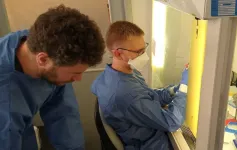(Press-News.org) Exercise has long-been recommended as a cognitive-behavioral therapy for patients of depression, yet new evidence from the University of California of San Diego suggests that the COVID-19 pandemic changed the nature of the relationship between physical activity and mental health.
In a study of college students conducted before and during the pandemic, findings revealed the average steps of subjects declined from 10,000 to 4,600 steps per day and rates of depression increased from 32% to 61%.
The research, recently published in the Proceedings of the National Academy of Sciences, also revealed short-term restoration of exercise does not meaningfully improve mental well-being.
"This raises many possible explanations, including that the impact of physical activity may require a longer-term intervention," said co-author Sally Sadoff, associate professor of economics and strategy at UC San Diego's Rady School of Management. "At the same time, our results clearly show that those who maintained physical exercise throughout the pandemic were the most resilient and least likely to suffer from depression."
Sadoff added there is a 15 to 18 percentage point difference in depression rates between participants who experienced large disruptions to their mobility, compared those who maintained their habits.
Sadoff and coauthors from the University of Pittsburg and Carnegie Mellon University point to the alarming trend of increased depression among young adults (ages 18-24) during the pandemic, which is two-times higher than the general population.
The students in the study answered repeated surveys about their well-being and time use over the course of a semester. From March to July 2020, depression rates skyrocketed by 90%, compared to pre-pandemic levels.
Fitbit data helps fill in the gaps in understanding mobility's role in mental health
The study enrolled multiple cohorts of hundreds of U.S. college students from February 2019 through July 2020. In addition to filling out surveys, participants received wearable devices (Fitbits) that track their activity levels. Participants in the 2020 cohort began the study in February and continued participating after their university moved all classes online in March and encouraged students not to return to campus.
Among the subjects, sleep increased by 25 to 30 minutes per night, time spent socializing declined by more than half (less than 30 minutes per day), and screen time more than doubled to five or more hours per day.
The researchers found large declines in physical activity during COVID-19 was most strongly associated with higher rates of depression. Physical activity minutes translate to about 10 minutes in which the heart rate is raised enough to burn at least 1.5 times as many calories as it does at rest.
Those who experienced declines of one to two hours of physical activity per day were most at risk for depression during the pandemic. While participants who were able to maintain their daily habits were at the lowest risk for depression.
"This relationship is one that only emerges during the pandemic," the authors note. "Before the pandemic, there was not a very strong connection between changes in physical activity and mental health, but our analyses suggest that disruption to physical activity is a leading risk factor for depression during this period."
Short-term restoration of exercise habits does not provide mental health relief
In order to examine whether a policy intervention could help counteract some of the pandemic's adverse impacts to mental health, the researchers implemented a randomized experiment.
Half of the participants were incentivized to walk at least 10,000 steps per day for two weeks. The strategy significantly increased their average steps by about 2,300 steps per day and physical activity by almost 40 min per day, compared to the other half of subjects. However, the impact of exercise did not translate into an improvement in mental health, nor did it encourage the students to keep up the physical activity after the two-week period ended.
"Physical activity may have important interactions with other lifestyle behaviors such as social interactions," the authors write. "It could also be the case that the relationship between physical activity and depression is driven more by mental health than it is by lifestyle habits."
They conclude more research is needed to understand how to improve both physical and mental health during such periods of large disruption.
Adding, "The pandemic tightened the relationship between the maintenance of lifestyle habits and mental health."
INFORMATION:
Co-authors include Osea Giuntella, assistant professor of economics at the University of Pittsburg; Kelly Hyde, graduate student in the department of economics at the University of Pittsburg; and Silvia Saccardo, assistant professor of management at Carnegie Mellon University.
During the first half of 2020, the U.S. Intermountain West region of the United States experienced four significant earthquake sequences, spanning multiple states. In the new issue of SRL, 15 papers characterize these major earthquakes and discuss how they are helping seismologists gain new insights into the tectonics of the region.
The Intermountain West is bounded by the eastern margin of the Sierra Nevada and Cascade Mountains to the west and the Rocky Mountains to the east. While its earthquake risk is often overlooked in comparison to those in California and the Pacific Northwest, the region ...
The COVID-19 pandemic has had a profound effect across society, but it has been especially devastating for people with substance use disorder.
A new study, published in the journal PLOS ONE, sheds light on the experience of patients with substance use disorder who were hospitalized during the initial surge of COVID-19 cases in Oregon last spring. Researchers with Oregon Health & Science University conclude that health systems nationwide could benefit from a better understanding of people who struggle with the basics.
"We need the system to be designed and implemented for patients who may lack phone access, who may not have access to WiFi or may be living on the streets," said lead ...
A combined treatment of irradiation and essential oil vapors could effectively destroy insects, bacteria and mold in stored grains. A team from the END ...
Being able to make blind people see again sounds like the stuff of miracles or even science fiction. And it has always been one of the biggest challenges for scientists. Diego Ghezzi, who holds the Medtronic Chair in Neuroengineering (LNE) at EPFL's School of Engineering, has made this issue a research focus. Since 2015, he and his team have been developing a retinal implant that works with camera-equipped smart glasses and a microcomputer. "Our system is designed to give blind people a form of artificial vision by using electrodes to stimulate their retinal cells," says Ghezzi.
Read more: https://actu.epfl.ch/news/a-retinal-implant-that-is-more-effective-against-b/
Star-spangled sky
The camera embedded in the smart glasses captures images in the wearer's field of vision, and ...
In order to stay alive, the cell must provide its various organelles with all the energy elements they need, which are formed in the Golgi apparatus, its centre of maturation and redistribution of lipids and proteins. But how do the proteins that carry these cargoes - the kinesins - find their way and direction within the cell's "road network" to deliver them at the right place? Chemists and biochemists at the University of Geneva (UNIGE), Switzerland, have discovered a fluorescent chemical dye, making it possible for the first time to track the transport ...
More Antarctic meltwater is surfacing than was previously known, modifying the climate, preventing sea ice from forming and boosting marine productivity- according to new research from the University of East Anglia (UEA).
For the first time, researchers have been able to obtain full-depth glacial meltwater observations in winter, using instruments attached to the heads of seals living near the Pine Island Glacier, in the remote Amundsen Sea in the west of Antarctica.
The harsh environmental conditions in the Antarctic limit the use of most traditional observation systems, such as ships and airplanes, especially ...
Researchers at Scripps Institution of Oceanography at UC San Diego examining 14 years of hospital admissions data conclude that the fine particles in wildfire smoke can be several times more harmful to human respiratory health than particulate matter from other sources such as car exhaust. While this distinction has been previously identified in laboratory experiments, the new study confirms it at the population level.
This new research work, focused on Southern California, reveals the risks of tiny airborne particles with diameters of up to 2.5 microns, about one-twentieth that of a human hair. These particles - termed PM2.5 - are the ...
Satellite imagery shows that the area covered by kelp forests off the coast of Northern California has dropped by more than 95 percent, with just a few small, isolated patches of bull kelp remaining. Species-rich kelp forests have been replaced by "urchin barrens," where purple sea urchins cover a seafloor devoid of kelp and other algae.
A new study led by researchers at UC Santa Cruz documents this dramatic shift in the coastal ecosystem and analyzes the events that caused it. This was not a gradual decline, but an abrupt collapse of the kelp forest ecosystem in the aftermath of unusual ocean warming along the West Coast starting in 2014, part of a series of events that combined to decimate the kelp forests.
Published March 5 in Communications Biology, ...
Quantitative real-time polymerase chain reaction (qPCR) is the most widely used diagnostic method to detect RNA viruses such as SARS-CoV-2. However, it requires expensive laboratory equipment and global shortages of reagents for RNA purification has increased the need to find simple but reliable alternatives. One alternative to the qPCR technology is RT-LAMP (reverse transcription loop-mediated isothermal amplification). This test amplifies the desired target sequences of the virus at a constant temperature, using minimal equipment compared to qPCR. In 2020, it was adapted to the detection of SARS-CoV-2. It was also shown that instead of a swab, which many people find unpleasant, it can be performed on gargle lavage samples.
First author Lukas Bokelmann and colleagues have now ...
Researchers from the Pan African Programme: The Cultured Chimpanzee (PanAf) at the Max Planck Institute for Evolutionary Anthropology (MPI-EVA) and a team of international researchers, collected over 5000 fecal samples from 55 sites in 18 countries across the chimpanzee range over 8 years. This is by far the most complete sampling of the species to date, with a known location of origin for every sample, thus addressing the sampling limitations of previous studies. "Collecting these samples was often a daunting task for our amazing field teams. The chimpanzees were almost all unhabituated to human presence, so it took a lot of patience, skill and luck to find chimpanzee dung at each of the sites," explains ...





